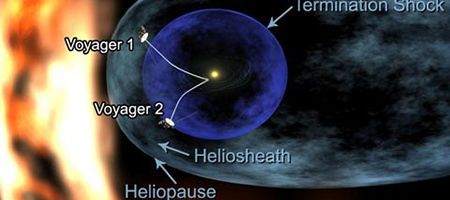After 33 years’ traveling, NASA’s Voyager 1 spacecraft has reached the point at the edge of the solar system where the solar wind has died down.

Now some 10.8 billion miles from the sun and heading for interstellar space, it’s crossed into an area where the velocity of the hot ionized gas, or plasma, streaming outward from the sun has slowed to zero.
Scientists suspect the solar wind has been turned sideways by the pressure from the interstellar wind in the region between stars.
“The solar wind has turned the corner,” says Ed Stone, Voyager project scientist. “Voyager 1 is getting close to interstellar space.”
Scientists have used data from Voyager 1’s Low-Energy Charged Particle Instrument to deduce the solar wind’s velocity. When the speed of the charged particles hitting the outward face of Voyager 1 matched the spacecraft’s speed, researchers knew that the net outward speed of the solar wind was zero. This occurred in June, when Voyager 1 was about 10.6 billion miles from the sun.
The velocity of the solar wind has steadily slowed at a rate of about 45,000 mph each year since August 2007, when the solar wind was speeding outward at about 130,000 mph. The outward speed has remained at zero since June.
“When I realized that we were getting solid zeroes, I was amazed,” said Rob Decker, a Voyager Low-Energy Charged Particle Instrument co-investigato. “Here was Voyager, a spacecraft that has been a workhorse for 33 years, showing us something completely new again.”
Scientists believe Voyager 1 has not yet crossed the heliosheath into interstellar space. This would mean a sudden drop in the density of hot particles and an increase in the density of cold particles. Scientists are using the new data to improve their models, but currently estimate that Voyager 1 will cross that frontier in about four years.
A sister spacecraft, Voyager 2, was launched in 1977 and is now 8.8 billion miles from the sun. In the next few years, scientists expect Voyager 2 to encounter the same kind of phenomena as Voyager 1.






